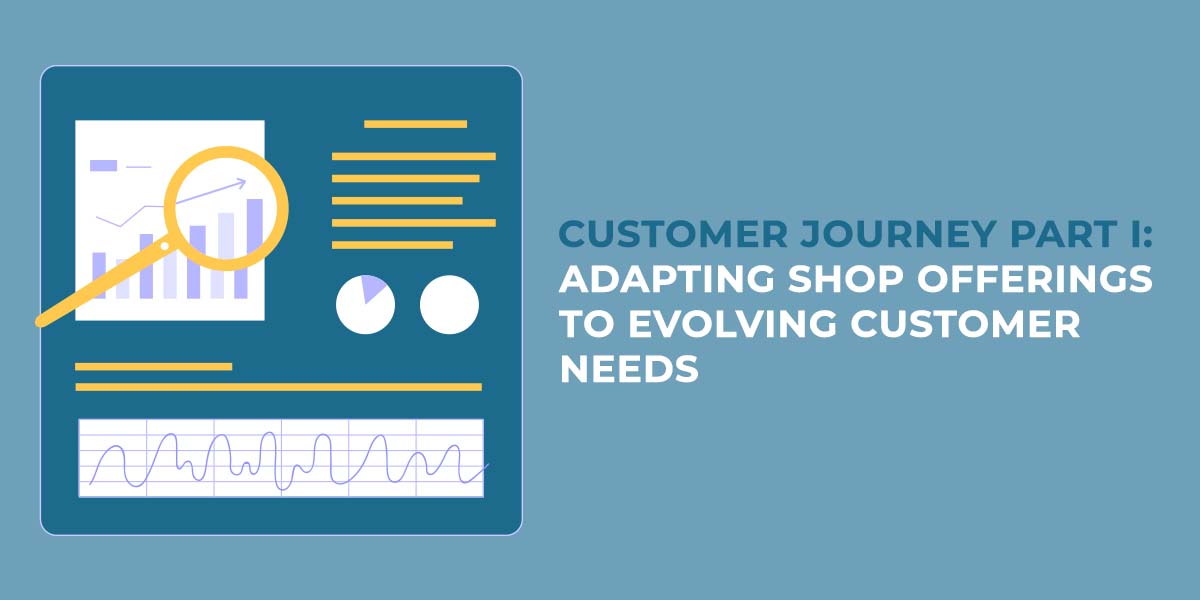Customer Journey Part I: Adapting Shop Offerings to Evolving Customer Needs
In today’s fast-paced market, staying adaptable to changing customer journeys is paramount for business success. As part of our new series focusing on the customer journey, this blog post will delve into strategies and insights on how businesses can continuously adjust their offerings to align with evolving consumer preferences. We’ll explore the current landscape of consumer behavior, the role of data analytics in identifying shifts, the importance of flexible inventory management, innovative product strategies, and effective communication methods.
By adopting these approaches, businesses can remain competitive and responsive in a rapidly shifting environment.
Customer Journey Insight 1: Understanding Dynamic Consumer Trends & Product Mix
Consumer behavior is constantly evolving, driven by technological advancements, cultural shifts, and economic changes. To stay ahead, businesses must understand these dynamic trends and adjust their product mix accordingly.
In recent years, consumer preferences have shifted significantly. With the rise of e-commerce, customers now expect seamless online shopping experiences. Social media influences purchasing decisions, with platforms like Instagram and TikTok becoming key marketing channels. Additionally, the demand for sustainable and ethically produced goods has surged, reflecting a growing awareness of environmental and social issues.
Adapting the product mix to reflect these trends is crucial. Businesses must offer products that meet current demands while anticipating future preferences. This might involve diversifying product lines, introducing new categories, or phasing out items that no longer resonate with customers.
Case Studies on Adapting to Consumer Trends
Consider the example of Nike, which has successfully adapted to consumer trends by embracing sustainability. The company’s “Move to Zero” campaign is a comprehensive initiative to reduce carbon emissions and waste throughout its production process. This campaign underscores Nike’s commitment to environmental responsibility, addressing the increasing consumer demand for eco-friendly products.
Nike’s approach involves several key strategies. Firstly, they have focused on using recycled materials in their products. For example, Nike’s Flyknit technology uses recycled plastic bottles to create lightweight, durable footwear. This reduces waste and showcases Nike’s innovation in sustainable design. Additionally, the company has committed to sourcing sustainable cotton and other materials, further minimizing their environmental impact.
Beyond materials, Nike has also implemented energy-efficient manufacturing processes. They have invested in renewable energy sources for their factories and are continuously exploring ways to reduce water usage and chemical waste. These efforts contribute to lowering the overall carbon footprint of their production operations.
The “Move to Zero” campaign is also heavily promoted through Nike’s marketing channels, reinforcing their brand message of sustainability. By highlighting their eco-friendly initiatives in advertisements, social media, and in-store displays, Nike effectively communicates their commitment to sustainability to a broad audience. This transparent approach not only educates consumers about their efforts but also builds trust and loyalty among environmentally conscious customers.
Moreover, Nike’s sustainability initiatives extend beyond product development. The company has engaged in community programs and partnerships aimed at promoting environmental stewardship. For example, Nike collaborates with organizations like the Ocean Conservancy to address ocean plastic pollution and supports initiatives that encourage recycling and sustainable living practices among consumers.
By integrating sustainable practices into their product development, manufacturing processes, and marketing strategies, Nike has not only reduced its environmental impact but also strengthened its brand appeal. Consumers today are more likely to support brands that align with their values, and Nike’s commitment to sustainability resonates deeply with this growing demographic. As a result, Nike has been able to enhance customer loyalty and maintain a competitive edge in the market, demonstrating the significant benefits of adapting to evolving consumer trends.
Customer Journey Insight 2: Data-Driven Customer Insights
In the digital age, data is a powerful tool for understanding and anticipating customer needs. Businesses that leverage data analytics can gain valuable insights into consumer behavior and preferences.
Data analytics allows businesses to track and analyze customer interactions, purchasing patterns, and feedback. By interpreting this data, companies can identify trends, predict future behavior, and make informed decisions about product offerings.
In today’s data-driven market, understanding and segmenting different customer personas based on data is essential for businesses aiming to stay relevant and competitive. Personas are detailed profiles that represent the distinct needs, behaviors, and preferences of various customer groups. By identifying these personas, businesses can tailor their offerings to meet the specific needs of each segment, ensuring a more personalized and effective approach to marketing and product development.
The Importance of Customer Personas
Customer personas help businesses to move away from a one-size-fits-all strategy and towards more targeted marketing efforts. These personas are created by analyzing data from various sources such as purchase history, website interactions, social media activity, and customer feedback. This data provides insights into what different segments of customers value, how they behave, and what influences their purchasing decisions.
Creating & Segmenting Customers
To create detailed customer personas, businesses should start by collecting and analyzing data from multiple touchpoints. This might include demographic information, buying patterns, and psychographic data such as interests and values. Surveys and interviews can also provide valuable qualitative data that helps flesh out the personas with deeper insights into customer motivations and pain points.
Once the data is collected, it should be segmented into distinct groups that share similar characteristics. For example, one persona might be “Eco-Conscious Emma,” a millennial who prioritizes sustainability in her purchases, while another might be “Tech-Savvy Tom,” a Gen Z consumer who is always on the lookout for the latest gadgets. Each persona should include details such as age, gender, occupation, buying behavior, and specific needs or preferences.
With well-defined personas, businesses can tailor their offerings to better meet the needs of each segment. For instance, email or PPC campaigns can be customized to resonate with different personas, highlighting aspects of a product that appeal to their specific interests. Eco-Conscious Emma might respond well to messaging about sustainable practices and eco-friendly products, while Tech-Savvy Tom might be more interested in cutting-edge technology and innovative features.
Benefits of Persona-Based Strategies
Implementing persona-based strategies offers several benefits. It enhances customer satisfaction by providing more relevant and personalized experiences. It also improves marketing efficiency by focusing efforts on the most promising segments, leading to higher conversion rates and customer retention. Furthermore, it helps in product development by ensuring that new products or features are aligned with the actual needs and preferences of different customer groups.
Continuous Updating and Refinement
Customer personas are not static; they should be continuously updated and refined as market conditions and consumer behaviors change. Regularly revisiting and analyzing customer data helps businesses to stay current with evolving trends and maintain the relevance of their personas. This ongoing process ensures that marketing strategies and product offerings remain aligned with the shifting needs of the target audience.
By identifying and understanding shifting personas, businesses can create more effective and personalized strategies that resonate with their customers. This approach not only improves customer satisfaction and loyalty but also drives better business outcomes in an increasingly competitive marketplace.
Tools and Technologies
There are several tools and technologies available to help businesses collect and analyze customer data. Platforms like Google Analytics, CRM systems like Salesforce, and social media analytics tools provide comprehensive insights into customer behavior. Utilizing these tools can help businesses stay attuned to shifting preferences and adjust their strategies accordingly.
Customer Journey Insight 3: Flexible Inventory Management
A flexible inventory strategy is crucial for accommodating changing consumer demands. By maintaining agility in inventory management, businesses can respond quickly to shifts in the market and avoid overstocking or stockouts.
In a dynamic market, customer demands can change rapidly. A flexible inventory strategy allows businesses to adapt to these changes, ensuring that they have the right products available at the right time. This flexibility can lead to increased customer satisfaction and reduced operational costs.
Best practices for managing inventory include just-in-time inventory, which minimizes storage costs by receiving goods only as they are needed. Additionally, businesses should implement robust demand forecasting techniques to predict future trends and adjust inventory levels accordingly.
Technology Solutions
A flexible inventory strategy is crucial for accommodating changing consumer demands. This adaptability ensures businesses can respond quickly to market shifts, avoiding overstocking, leading to increased customer satisfaction and reduced operational costs. Best practices include just-in-time inventory and robust demand forecasting to predict trends and adjust stock levels accordingly.
Inventory management software enhances this flexibility by offering features like real-time inventory tracking, automated reordering, and advanced demand forecasting. These tools enable continuous monitoring of stock levels, automatic restocking, and accurate planning based on historical data and predictive analytics. Integrating these platforms with other business systems, such as point-of-sale and e-commerce platforms, ensures a seamless flow of information, improving overall efficiency and decision-making. By leveraging such technology, businesses can maintain the agility needed to meet customer expectations and stay competitive in a rapidly changing market.
Customer Journey Insight 4: Innovative Product Strategy
To remain competitive, businesses must continuously innovate and adapt their product offerings. This involves not only introducing new products but also improving existing ones to meet evolving customer needs.
Apple is a prime example of a company that has successfully adapted its product strategy over the years. From the introduction of the iPod to the development of the iPhone and the Apple Watch, the company has consistently innovated to meet changing consumer preferences and technological advancements.
Encouraging a culture of innovation within the organization is key. Businesses should foster an environment where creativity is valued, and new ideas are encouraged. This can be achieved through regular brainstorming sessions, investing in research and development, and staying abreast of industry trends.
Collaboration with customers can also drive innovation. By soliciting feedback and involving customers in the product development process, businesses can ensure that their offerings align with market demands. Techniques such as crowdsourcing ideas and conducting focus groups can provide valuable insights into customer needs and preferences.
Customer Journey Insight 5: Effective Communication Strategies
Effectively communicating changes to your audience is crucial for maintaining customer trust and loyalty. Clear and transparent communication ensures that customers are aware of new offerings and understand the reasons behind changes.
Clear communication helps manage customer expectations and fosters a positive relationship between the business and its customers. It ensures that customers are informed about new products, changes to existing ones, and the rationale behind these changes.
Businesses should use multiple channels to communicate with their audience. This includes social media, email marketing, website updates, and in-store signage. Each channel should convey a consistent message that aligns with the brand’s voice and values.
The Power of Positive Reviews
Positive reviews and testimonials can significantly impact customer perception. Encouraging satisfied customers to share their experiences on platforms like Google Reviews, Yelp, and social media can enhance the business’s reputation and attract new customers. Highlighting these reviews in marketing materials and on the website can further reinforce the brand’s credibility.
In a dynamic market, staying adaptable to evolving customer needs is essential for business success. By understanding consumer trends, leveraging data-driven insights, maintaining flexible inventory management, developing innovative product strategies, and effectively communicating changes, businesses can remain competitive and responsive. This is just the beginning of our Customer Journey series, where we will continue to explore strategies and insights to help businesses thrive in an ever-changing landscape. Stay tuned for more valuable content that will guide you through the complexities of the customer journey – or, if you’d like to chat, we’d love to craft a campaign for your business that works for you.
Digital Marketing No To The Quo



